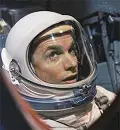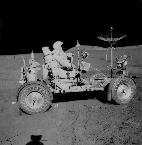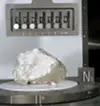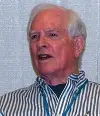Dave Scott: Pilot, Astronaut, 7th Man on the Moon
Dave Scott is a former military pilot and astronaut. He made three spaceflights, including two Apollo missions, during one of which he became the seventh person to walk on the Moon. 
He was born on June 6, 1932, at Randolph Field, near San Antonio, Texas. His father, Tom Scott, was stationed at the U.S. Army Air Corps base, and young Dave lived a few years there before his father moved to an Indiana air base and then to Manila, in the Philippines. The family lived there from 1936 to 1939, then returned to the U.S. Tom Scott shipped out not long after the Japanese attack on Pearl Harbor. Spending time with family friend David Shattuck, young Dave Scott enjoyed building model airplanes and watching films about flying. He flew with his father when the latter returned fro the war. The family moved to Riverside, Calif., and Dave attended Riverside Polytechnic High School. After one more move, he graduated from Western High School, in Washington, D.C., in 1949. The following year, Scott enrolled at the U.S. Military Academy. He graduated from West Point with a bachelor of science degree in military science in 1954, the year that the Air Force Academy was founded. He earned an Air Force commission and set about pilot training, first at Marana Air Base in Arizona and then at Webb Air Force Base in Texas. Scott flew for four years at Soesterberg Air Base in the Netherlands, in 1956 being put on high alert during the Hungarian Revolution. 
Returning to the U.S. in 1960, he enrolled at the Massachusetts Institute of Technology and earned a master of science degree in aeronautics and astronautics and an engineer in aeronautics/astronautics degree in 1962. Focused on starting a career as a test pilot, Scott challenged Air Force orders to be a professor at the Air Force Academy and won an appointment at the Air Force Test Pilot School at California's Edwards Air Force Base. At the time, commandant of the school was Scott's childhood idol, Chuck Yeager, the first person to break the sound barrier. Scott graduated first in his class and made it into the Aerospace Research Flight School. Scott joined the National Aeronautics and Space Administration (NASA) in 1963 as part of Astronaut Group 3. He flew aboard Gemini 8, along with Neil Armstrong on March 16, 1966. They performed the first docking in space. They had planned some time outside the capsule as well, but a thruster malfunction created a near-death experience for the astronauts, who finally disengaged their spacecraft from the Agena docking craft and headed for home. Scott was part of a backup crew for Apollo 1. The fire that killed that crew delayed the next Apollo launch; as part of the changes that followed an exhaustive investigation into the causes of the fire, Scott was in charge of designing a hatch that would open outwards. Named Commander of Apollo 9, Scott flew with Jim McDivitt and Rusty Schweickart on March 3, 1969. The original launch date was February 28, but when all three astronauts came down with colds, NASA postponed the launch. Blastoff was on March 3, 1969. The crew spent 10 days in low Earth orbit, performing all manner of tests: of docking and undocking maneuvers, of the engines of the lunar module, of navigation systems, of backpack life support systems. They even threw in a spacewalk, with Schweickart notching 37 minutes of extravehicular activity (EVA). 
One of the tests was for one of the crew to climb from one spacecraft to the other. In the all-important rehearsals for the worst case scenario, scientists wanted to be confident that the astronauts could do such a thing if the command module and lunar module wouldn't come together while orbiting the Moon. Schweikart was ill again on the day of the EVA, and so his spacewalk was more of a space-stand and missed out the test of the Portable Life Support System backpack. 
For the first time, the crew assigned nicknames to the main modules. The command module they called Gumdrop because it looked like one of the iconic sweets when wrapped up before launch. Spider, the name of the lunar module, was more evident because that craft looked very much like one of Earth's many arachnids. A big highlight for the crew was on the fifth day of the 10-day mission. McDivitt and Schweikart climbed into Spider and flew the lunar module more than 100 miles away from Gumdrop. In a rehearsal for what astronauts who had walked on the Moon would later do, the lunar module crew then enticed their spacecraft to "rise" again, and they docked safely with Scott in the command module. Their tests finished and 152 orbits completed, the crew returned safety to Earth, splashing down in the Atlantic Ocean on March 13. Scott was backup commander for Apollo 12, the second mission to land people on the Moon. The primary crew for that mission performed all of the tasks and made it home safely, so Scott and the rest of the backup crew were spared from having to spring into action. Next up for Scott was his next command, Apollo 15. Joining Scott in the crew were Command Module Pilot Al Worden and Lunar Module Pilot Jim Irwin. Among the improvements were redesigned space suits and backpacks. Those worn by Scott and Irwin had the addition of a liquid cooling garment. 
One of the big highlights of this mission was the debut of the Lunar Roving Vehicle. The 460-pound rolling craft could be folded into a space 5 feet by 20 inches and could carry a total of 1500 pounds, including the two astronauts. Each wheel had its own 200-watt electric motor. The craft could top a speed of 8 miles per hour. Blastoff was on the morning of July 26, 1961. The crew overcame a few technical difficulties along the way, including a leak in the water system that they plugged, and entered lunar orbit three days later. Scott and Irwin climbed into the Lunar Module and landed on the lunar surface on July 30, near Hadley Rille. In order to get a view as high as possible, Scott climbed into the top hatch for a survey of the landscape. It was the only standup extravehicular activity (EVA) of any lunar landing mission. He and Irwin then slept for a time before strapping on their spacesuits and stepping onto the lunar surface. They deployed the Rover, which contained a remote TV camera, and then settled in for a drive on the Moon. As had previous Apollo crews, Scott and Irwin collected a number of samples of lunar dust and rocks, the utility of the Rover giving them the ability to range
relatively far and wide from their landing craft. Back at the Lunar Module, Scott employed a U.S. Postal Service kit to cancel a first day cover of two stamps being issued on that day, August 2. Then, he performed one of the Apollo program's most important experiments: The Lunar Module crew rendezvoused with the Command Module, and all three traveled back to Earth safely, splashing down on August 7. The crew were involved in a controversy after they landed. All three had agreed to carry postal covers to the Moon and, after returning them to Earth, hand them over to a West German stamp dealer, who planned to sell them. The dealer paid each astronaut for doing this, and the crew had planned to use the money as a nest egg for their children. However, they did not have permission from NASA to do so. The space agency had sanctioned the first-day-cover exercise that Scott had undertaken, with full support of the U.S. Postal Service. But this was something different. When the crew's actions became public knowledge, they received official reprimands from NASA and were removed as the backup crew for Apollo 17. None of them flew in space again. Scott moved out of the astronaut corps and went to work on the Apollo-Soyuz project, a joint docking of an American and a Soviet project. Among other things, Scott met with Alexei Leonov, the Soviet mission commander; the two would later write a joint autobiography. In 1973, Scott became deputy director of the Dryden Flight Research Center. Two years later, he was named center director. Also in that year, he retired from the Air Force. Entering the private sector, Scott founded his own technology company and worked as a civilian on several projects for the U.S. Government. He also played in a role in a series of media projects:
He has been married twice and has two children. |
|
Social Studies for Kids
copyright 2002–2025
David White



 Among the rocks that they brought back was the so-called Genesis Rock, thought to have been part of the lunar crust from earliest times.
Among the rocks that they brought back was the so-called Genesis Rock, thought to have been part of the lunar crust from earliest times. proving the theory of noted Italian scientist Galileo Galilei that objects in the same gravity field, even if they have different weights, fall at the same rate in the absence of aerodynamic drag. Galileo had attempted to prove his experiment by dropping various objects from the top of the Leaning Tower of Pisa and other places, but the air resistance of the Earth had always gotten in the way. Scott held a hammer in one hand and a feather in the other hand and dropped them at the same time. With the television cameras rolling, the hammer and the feather
proving the theory of noted Italian scientist Galileo Galilei that objects in the same gravity field, even if they have different weights, fall at the same rate in the absence of aerodynamic drag. Galileo had attempted to prove his experiment by dropping various objects from the top of the Leaning Tower of Pisa and other places, but the air resistance of the Earth had always gotten in the way. Scott held a hammer in one hand and a feather in the other hand and dropped them at the same time. With the television cameras rolling, the hammer and the feather  He was a commentator for U.K. TV for the first Space Shuttle flight, in April 1981.
He was a commentator for U.K. TV for the first Space Shuttle flight, in April 1981.
